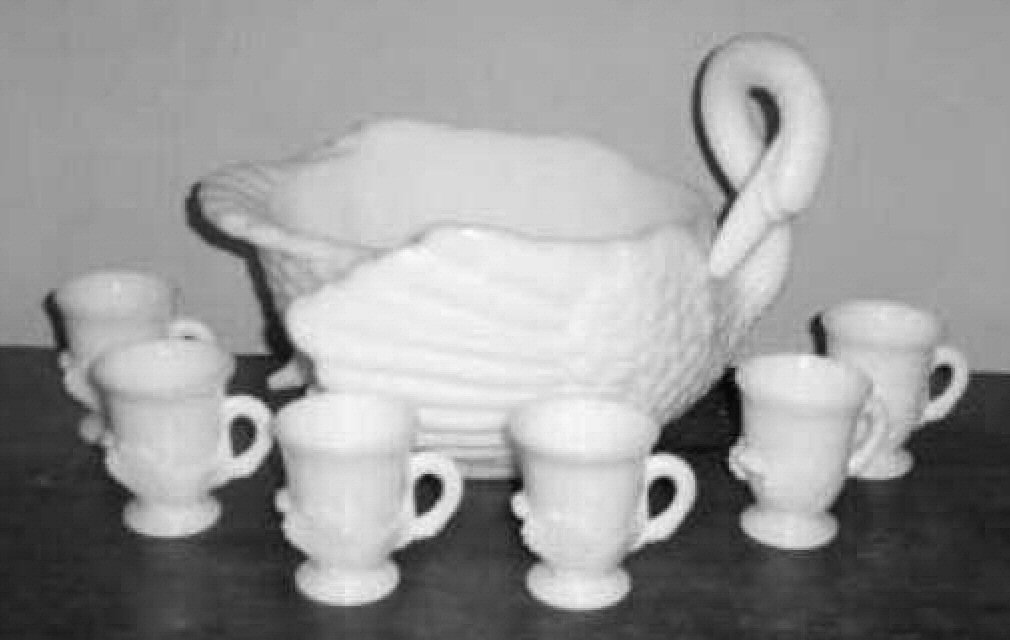You are here
The Swan Punch Bowl and other Cambridge Swans
THE SWAN PUNCH BOWL…
AND OTHER CAMBRIDGE SWANS by Les Hansen
Published September 2005
 Milk Glass Swan Punch bowl & matching Swan Cups |
Numerous NCC members have commented about an episode of the television program, Antiques Roadshow, which correctly credited a 13” Light Emerald Green swan as being made by Cambridge Glass Company. That wasn’t too tough for the appraiser to do – after all, the swan had the “C in the triangle” mark on its base. Unfortunately, the appraiser incorrectly identified the swan as a 16” punch bowl and assigned an estimated value that is far above the general market value for this particular 13” swan. Subsequently, several 13” Light Emerald Green swans appeared on Ebay with the inaccurate punch bowl identification and mentioning the inflated appraisal value.
The size of Cambridge swans is based on their length, which is measured from the front of the breast (not the front of the beak) to the back of the tail. Confusion results because 13” swans (from breast to tail) typically are 16” long when measured from the front of the beak to the back of the tail (the distance from the front of the beak to the breast is included). Swan punch bowls are 16” long from breast to tail.
Frequently at glass shows and in ebay listings, I see 13” crystal swans (those without feather detail – called “type 3”) labeled as “small punch bowls”. However, a 13” swan would indeed be a dinky punch bowl! As far as we know, Cambridge never referred to 13” swans as punch bowls. Consistently, Cambridge marketed 13” swans as centerpieces, and sold them both with and without 3 ½” flower blocks.
Swan punch bowls must have been popular sellers for Cambridge, because the company made them for at least 21 years. The earliest known reference to the production of the swan punch bowl is 1937, and the punch bowls appeared on company price lists until the final closing of the company in 1958. The vast majority of the swan punch bowls are alike in general form – crystal and completely lacking feather detail. For a short time (probably form 1937 to 1939), Cambridge made crystal swan punch bowls with some feather detail that were also marked with the ”C in a triangle”. Furthermore, only in 1954, the swan punch bowl was produced in Milk. Few Milk swan punch bowls have survived, and this punch bowl is a prized addition to Cambridge glass collections today.
I authored a series of six articles on Cambridge swans that appeared in the Crystal Ball between June 1999 and February 2000 (issues 314, 315, 317, 319, 322, and 323). The six articles go into great detail on the sizes, styles, colors, and decorations of Cambridge swans – there is a lot of information to be shared on Cambridge swans, including reissues of the swans by other manufacturers. Incidentally, the swan punch bowl wasn’t reissued by other manufacturers. Cambridge made swan punch cups to go with the swan punch bowls. The punch cups have necks of swans as handles and a perfectly round top.
A review of the intended uses (sometimes multiple) for the various sizes of Cambridge swans:
| 3” | Individual Nut, Mint, or Ashtray |
| 4½” | Candy Dish |
| 6½” | Mayonnaise (when sold with a ladle) or Candy Dish |
| 8½” | Celery Holder, Bonbon, or Centerpiece (when sold with a 2 ¾” flower block) |
| 10” | Centerpiece (sold with or without 3” flower block) * |
| 13” | Centerpiece (sold with or without 3 ½” flower block) |
| 16” | Punch Bowl |
| *The 10” Swan is frequently used as a bowl for an 8” figural flower frog, on an oval base. | |